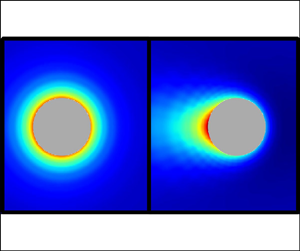Article contents
Nonlinear electrophoretic velocity of a spherical colloidal particle
Published online by Cambridge University Press: 31 July 2023
Abstract

Electrophoresis is the motion of a charged colloidal particle in an electrolyte under an applied electric field. The electrophoretic velocity of a spherical particle depends on the dimensionless electric field strength  $\beta =a^*e^*E_\infty ^*/k_B^*T^*$, defined as the ratio of the product of the applied electric field magnitude
$\beta =a^*e^*E_\infty ^*/k_B^*T^*$, defined as the ratio of the product of the applied electric field magnitude  $E_\infty ^*$ and particle radius
$E_\infty ^*$ and particle radius  $a^*$, to the thermal voltage
$a^*$, to the thermal voltage  $k_B^*T^*/e^*$, where
$k_B^*T^*/e^*$, where  $k_B^*$ is Boltzmann's constant,
$k_B^*$ is Boltzmann's constant,  $T^*$ is the absolute temperature, and
$T^*$ is the absolute temperature, and  $e^*$ is the charge on a proton. In this paper, we develop a spectral element algorithm to compute the electrophoretic velocity of a spherical, rigid, dielectric particle, of fixed dimensionless surface charge density
$e^*$ is the charge on a proton. In this paper, we develop a spectral element algorithm to compute the electrophoretic velocity of a spherical, rigid, dielectric particle, of fixed dimensionless surface charge density  $\sigma$ over a wide range of
$\sigma$ over a wide range of  $\beta$. Here,
$\beta$. Here,  $\sigma =(e^*a^*/\epsilon ^*k_B^*T^*)\sigma ^*$, where
$\sigma =(e^*a^*/\epsilon ^*k_B^*T^*)\sigma ^*$, where  $\sigma ^*$ is the dimensional surface charge density, and
$\sigma ^*$ is the dimensional surface charge density, and  $\epsilon ^*$ is the permittivity of the electrolyte. For moderately charged particles (
$\epsilon ^*$ is the permittivity of the electrolyte. For moderately charged particles ( $\sigma ={O}(1)$), the electrophoretic velocity is linear in
$\sigma ={O}(1)$), the electrophoretic velocity is linear in  $\beta$ when
$\beta$ when  $\beta \ll 1$, and its dependence on the ratio of the Debye length (
$\beta \ll 1$, and its dependence on the ratio of the Debye length ( $1/\kappa ^*$) to particle radius (denoted by
$1/\kappa ^*$) to particle radius (denoted by  $\delta =1/(\kappa ^*a^*)$) agrees with Henry's formula. As
$\delta =1/(\kappa ^*a^*)$) agrees with Henry's formula. As  $\beta$ increases, the nonlinear contribution to the electrophoretic velocity becomes prominent, and the onset of this behaviour is
$\beta$ increases, the nonlinear contribution to the electrophoretic velocity becomes prominent, and the onset of this behaviour is  $\delta$-dependent. For
$\delta$-dependent. For  $\beta \gg 1$, the electrophoretic velocity again becomes linear in field strength, approaching the Hückel limit of electrophoresis in a dielectric medium, for all
$\beta \gg 1$, the electrophoretic velocity again becomes linear in field strength, approaching the Hückel limit of electrophoresis in a dielectric medium, for all  $\delta$. For highly charged particles (
$\delta$. For highly charged particles ( $\sigma \gg 1$) in the thin-Debye-layer limit (
$\sigma \gg 1$) in the thin-Debye-layer limit ( $\delta \ll 1$), our computations are in good agreement with recent experimental and asymptotic results.
$\delta \ll 1$), our computations are in good agreement with recent experimental and asymptotic results.
JFM classification
Information
- Type
- JFM Papers
- Information
- Copyright
- © The Author(s), 2023. Published by Cambridge University Press
References
- 13
- Cited by


